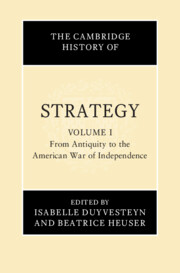Book contents
- The Cambridge History of Strategy
- The Cambridge History of Strategy
- The Cambridge History of Strategy
- Copyright page
- Dedication
- Contents
- Maps
- Contributors to Volume I
- Preface and Acknowledgements
- Introduction to Volume I
- 1 China to ad 180
- 2 Teispid and Achaemenid Persia (c. 550–330 bc)
- 3 Ancient Greece
- 4 Philip II, Alexander III and the Macedonian Empire
- 5 Ancient Rome: Monarchy and Republic (753–27 bc)
- 6 China ad 180–1127
- 7 Ancient Rome
- 8 The Gupta Empire (ad 400–500)
- 9 The Sassanian Empire’s Strategies
- 10 The Rashidun, Umayyad (661–750) and Abbasid (750–1258) Caliphates
- 11 Byzantine Strategy (ad 630–1204)
- 12 Strategies in the Wars of Western Europe, 476–c. 1000
- 13 Latin Christendom in the Later Middle Ages
- 14 Chinggis Khan and the Mongol Empire, ad 1206 to 1368
- 15 Hindu and Buddhist Polities of Premodern/Early Modern Mainland South-East Asia (1100–1800)
- 16 Pre-Columbian and Early Historic Native American Warfare
- 17 Ottoman Expansionism, 1300–1823
- 18 Strategy in the Wars of Pre-colonial Sub-Saharan Africa
- 19 Strategies of the Mughal Empire
- 20 China, 1368–1911
- 21 Early Modern Europe: The Habsburgs and Their Enemies, 1519–1659
- 22 Naval Strategies
- 23 The Strategy of Louis XIV
- 24 Hohenzollern Strategy under Frederick II
- 25 American Warfare in the Eighteenth Century
- Summary of Volume I
- Further Reading
- Index
9 - The Sassanian Empire’s Strategies
Published online by Cambridge University Press: 06 January 2025
- The Cambridge History of Strategy
- The Cambridge History of Strategy
- The Cambridge History of Strategy
- Copyright page
- Dedication
- Contents
- Maps
- Contributors to Volume I
- Preface and Acknowledgements
- Introduction to Volume I
- 1 China to ad 180
- 2 Teispid and Achaemenid Persia (c. 550–330 bc)
- 3 Ancient Greece
- 4 Philip II, Alexander III and the Macedonian Empire
- 5 Ancient Rome: Monarchy and Republic (753–27 bc)
- 6 China ad 180–1127
- 7 Ancient Rome
- 8 The Gupta Empire (ad 400–500)
- 9 The Sassanian Empire’s Strategies
- 10 The Rashidun, Umayyad (661–750) and Abbasid (750–1258) Caliphates
- 11 Byzantine Strategy (ad 630–1204)
- 12 Strategies in the Wars of Western Europe, 476–c. 1000
- 13 Latin Christendom in the Later Middle Ages
- 14 Chinggis Khan and the Mongol Empire, ad 1206 to 1368
- 15 Hindu and Buddhist Polities of Premodern/Early Modern Mainland South-East Asia (1100–1800)
- 16 Pre-Columbian and Early Historic Native American Warfare
- 17 Ottoman Expansionism, 1300–1823
- 18 Strategy in the Wars of Pre-colonial Sub-Saharan Africa
- 19 Strategies of the Mughal Empire
- 20 China, 1368–1911
- 21 Early Modern Europe: The Habsburgs and Their Enemies, 1519–1659
- 22 Naval Strategies
- 23 The Strategy of Louis XIV
- 24 Hohenzollern Strategy under Frederick II
- 25 American Warfare in the Eighteenth Century
- Summary of Volume I
- Further Reading
- Index
Summary
For over 400 years, Sassanid Persia was the greatest state in Asia. To the east, the Kushan Empire was already in decline. The only strong opponent of Iran was the Roman Empire in the west. Military competition for influence in northern Mesopotamia, Armenia and the Caucasus region dominated Iranian–Roman relations, orienting the strategic activities of the early Sassanids to the western fringes of the empire. The breakthrough came in the mid-fourth century, with the emergence of the Kidara Huns in the east. Iran faced a ‘strategic dilemma’: it was crucial to avoid wars on multiple fronts. The Hephthalites or White Huns, became the most important enemy of the Sassanians until the end of the following century; the adoption of such a strategic paradigm enforced the maintenance of peace with the Roman Empire in the west. However, the Sassanian ruler, having secured the eastern territories, was able to move against Iran’s age-old enemy, Rome, this way beginning a period of wars in the west that, with few interruptions, lasted almost until the collapse of the Persian state. Defending such an enormous area was a challenge, as was preventing it from centrifugal tendencies, typical for multi-ethnic states. Despite these factors, the Iranian state managed to assure the territorial integrity of its core areas for four centuries. The tool to achieve this was the army – mobile, efficient, disciplined and motivated.
- Type
- Chapter
- Information
- The Cambridge History of Strategy , pp. 191 - 203Publisher: Cambridge University PressPrint publication year: 2025

